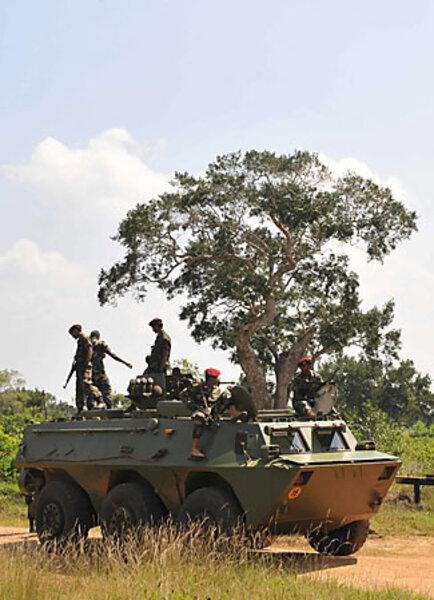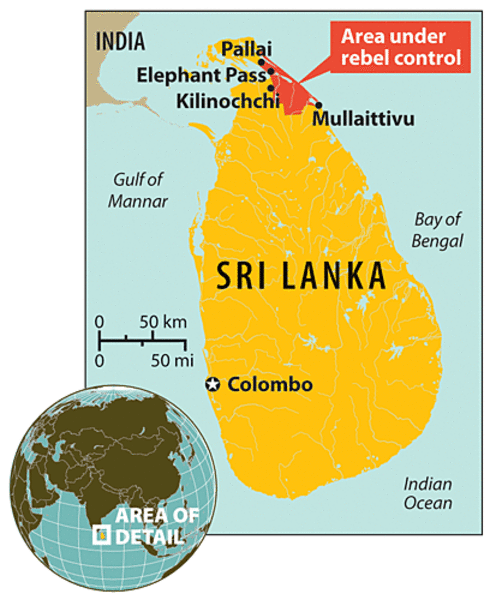Gauging Sri Lanka's inroads in battle against Tigers
Loading...
| Pune, India
The Sri Lankan Army made significant inroads against the rebel Tamil Tigers in the past week – seizing their de facto capital and another key town, squeezing fighters from north and south – but these military victories are unlikely to mark the end of the island's quarter-century-old conflict.
Like many guerrilla groups, the Liberation Tigers of Tamil Eelam (LTTE) can resort to a military Plan B: retreat from towns but continue its battle from the jungle, making it difficult for the government to assert control over the long-embattled north.
"This [victory in Kilinochchi] is a huge military achievement with significant political ramifications," says Ashok Mehta, a retired general who led an unsuccessful Indian peacekeeping force against the Tigers in 1987. "But will it end the war? No."
Even if all Tiger-held territory is captured, it will only "end the conventional phase of the war," Mr. Mehta adds. From their hideout in the jungles, the Tigers may continue to wage "guerrilla attacks backed by suicide terrorist attacks."
Sri Lankan forces have boxed in the Tigers' territory since taking control of Pallai to the north on Thursday and Kilinochchi, the rebels' administrative capital, to the south last Friday. Between the two towns lies the strategic Elephant Pass, which connects Jaffna Peninsula in the north with the rest of the island.
The Army is also pushing toward Mullaithivu, a town southeast of Kilinochchi and the Tigers' final stronghold in the north of the island.
The fall of Mullaithivu "is only a matter of time," says Mehta, adding that Kilinochchi provides a strategic base from which the Sri Lankan Army can wage that offensive.
On Wednesday, the government formally banned the Tigers and vowed to crush them. The move is largely symbolic, since the Army ended its 2002 Norway-backed cease-fire with the Tigers a year ago and began a military offensive.
These gains come after two years of military victories over the Tigers, during which they were driven out from the east of the island, and lost a vast swath of their territory in the north.
The government has hailed last week's seizure of Kilinochchi as a decisive victory. "Whatever the words or language used to describe it, this is truly an incomparable victory," President Mahinda Rajapaksa said last week. "What our heroic troops have achieved is not only the capture of the great fortress of the LTTE, but a major victory in the world's battle against terrorism."
Yet control of Kilinochchi has switched hands several times in the past few decades, a reminder of the challenges the government faces in retaining control of reclaimed areas. The Tamil Tigers first seized control of Kilinochchi in 1990, lost it in 1996 to the Army, then recaptured it two years later. Under their control the city became the rebels' de facto capital, with civil courts, police, and administrative offices.
In a defiant statement issued Thursday, LTTE political chief B. Nadesan noted that "Kilinochchi town was captured more than once by the Sri Lanka military earlier."
"Similarly, we have also recaptured the town on earlier occasions, effectively bringing the town under our control to serve the administrative and infrastructure needs," the statement read.
"Even after the fall of Kilinochchi," says Paikiasothy Saravanamuttu, the director of Center for Policy Alternatives (CPA), a think tank based in Colombo, "a low-level insurgency could last forever unless there is a negotiated settlement with the Tamils."
The Tigers have battled for more than a quarter century to establish an independent political state for ethnic Tamils, who make up about 18 percent of the population. In a CPA survey conducted in mid-2008, 83 percent of Tamils polled said the way to end the conflict and attain peace in Sri Lanka is to stop the war and hold political negotiations.
Among the country's ethnic Sinhalese, who make up about 74 percent of the population, 48 percent believe that the solution is for the government to wipe out the Tigers.
Fighting in recent months has forced some 250,000 civilians to flee their homes, according to the Law and Society Trust, a nongovernmental organization based in Colombo .
• Wire material was used for this report.






